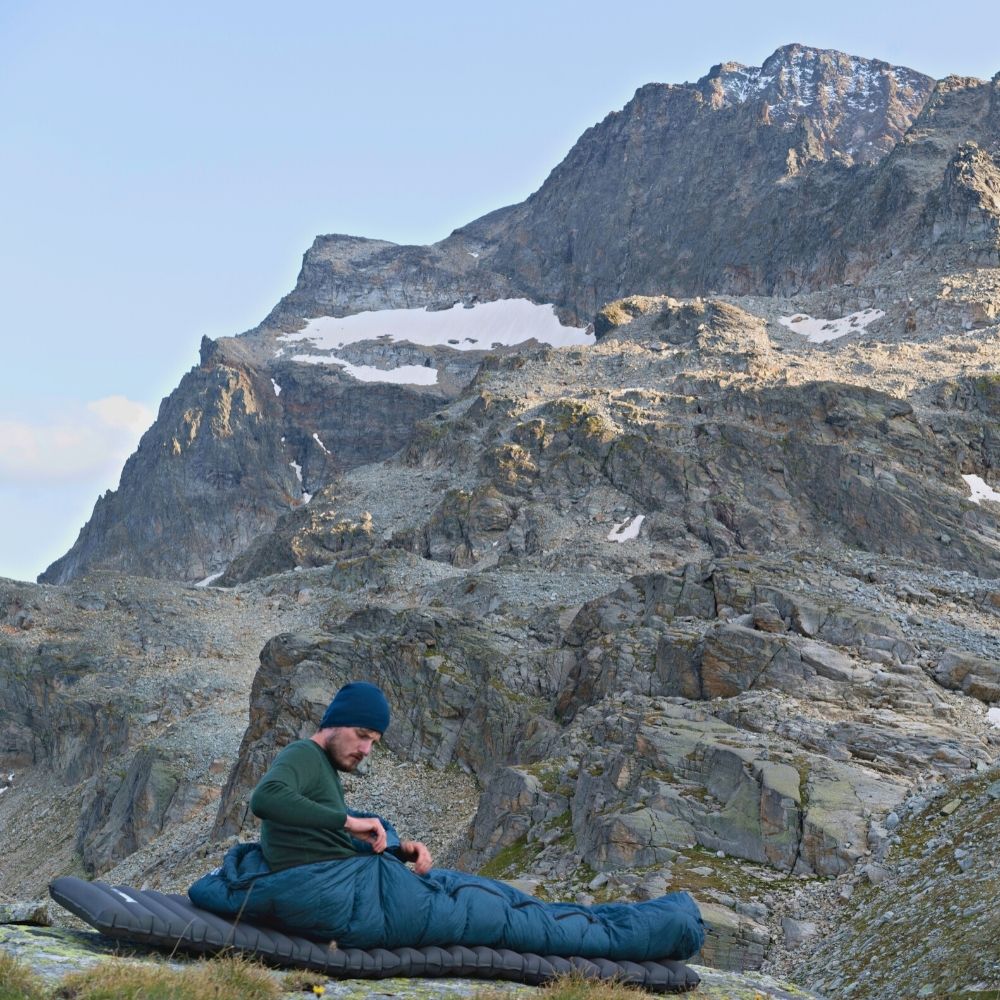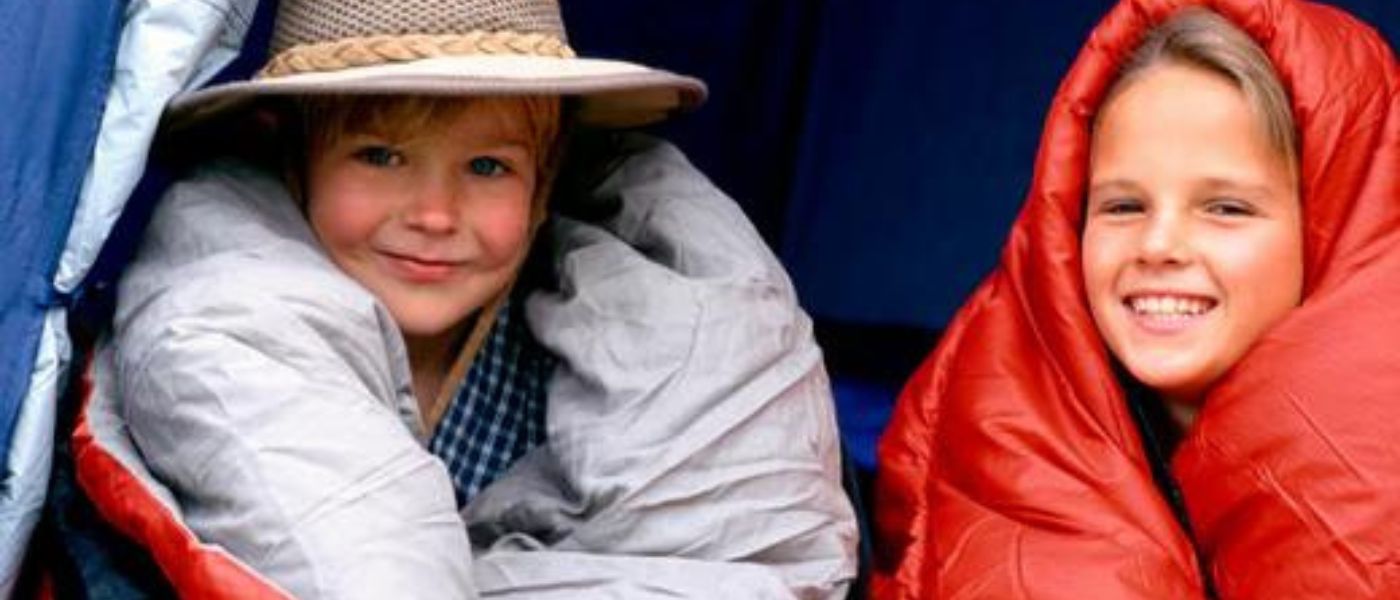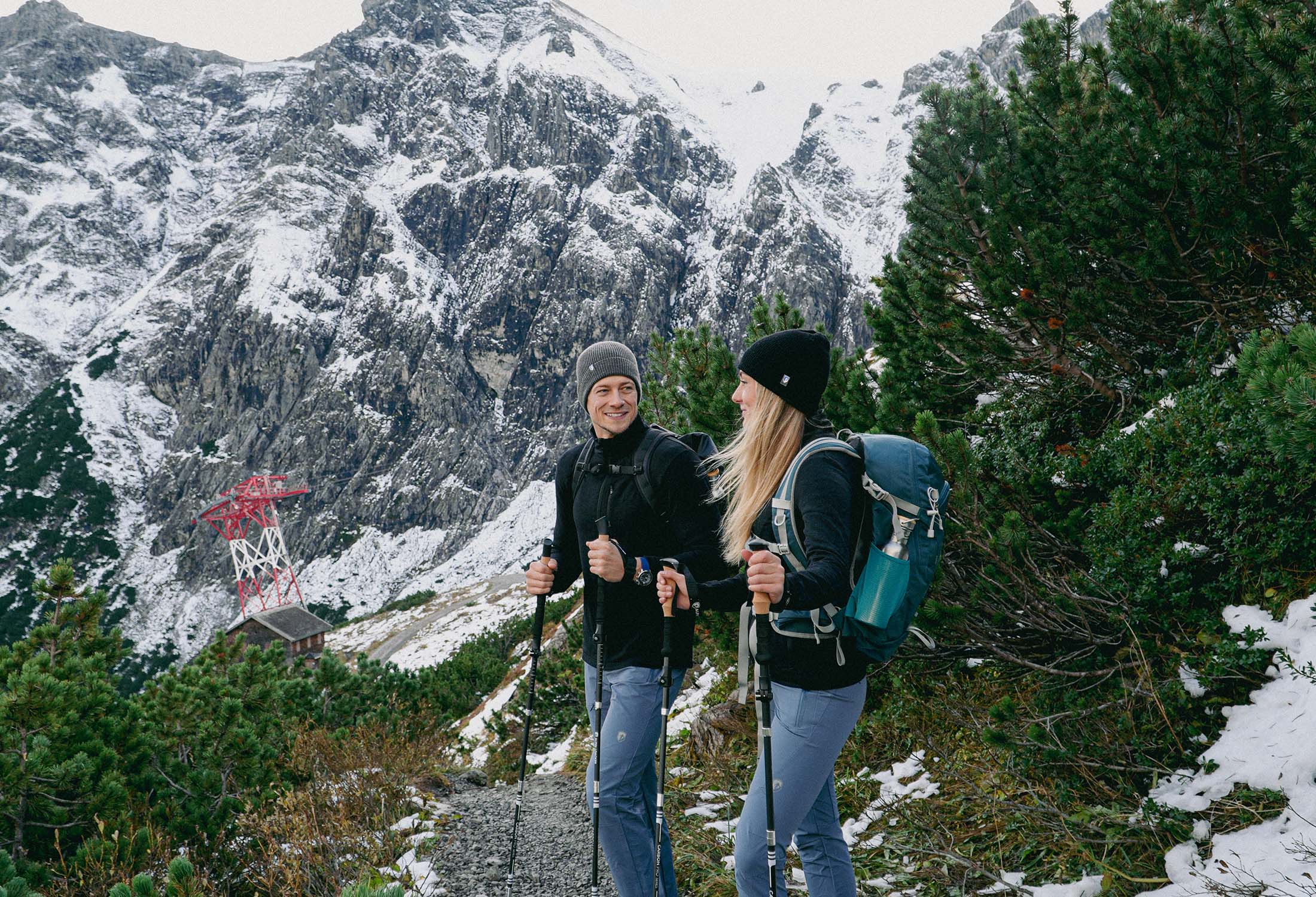Ist ein 4 Jahreszeiten Schlafsack ein Winterschlafsack?
Ein 4 Jahreszeiten Schlafsack wird im Sommer hauptsächlich in höheren Regionen verwendet bzw. Gebieten, in denen die Temperaturen auch im Sommer stark fallen können. Im Sommer kann die Temperatur auch in höheren Bergregionen unter 0 sinken. Wenn Du im Sommer auf einem Gletscher übernachtest und Eis unter dir hast, wird die Frage nach welchem Schlafsack hinfällig - damit Du bei diesem Abenteuer nicht frieren musst, brauchst du unbedingt einen warmen 4 Jahreszeiten Schlafsack und vorallem eine gute Isolierung von unten - sprich Isomatte.
Die Antwort auf die Frage ist also Ja und Nein!
Manche Hersteller sprechen auch von einem 5-Season Schlafsack. Dahinter befindet sich aber dasselbe Modell wie bei einem 4-Jahreszeiten-Schlafsack.
Was bedeutet 4 Jahreszeiten Schlafsack?
Unter bestimmten Bedingungen ist ein 4-Jahreszeiten-Schlafsack für den Einsatz das ganze Jahr hindurch geeignet.
Ein ganzjahres Schlafsack muss vor allem auch im Winter verwendbar sein. Das bedeutet,
seine Isolation muss Temperaturen von -17 °C bis +4°C abdecken können. Sprich - die Komforttemperatur sollte etwa bei -10 °C liegen. Was man unter Komforttemperatur versteht, kannst Du in unserem Blogbeitrag: “Winterschlafsack für den Outdoorbereich, Hilfestellung fürs Schlafsack kaufen” nachlesen.

Der 4 Jahreszeiten Schlafsack ist, wie der Name schon sagt, für das ganze Jahr - unter bestimmten Bedingungen, anwendbar.
Wie lang sollte der Reißverschluss eines 4-Jahres Schlafsackes sein?
Der 4-Jahreszeiten-Schlafsack benötigt sowohl eine sehr gute Isolation als auch eine ausreichende Belüftung, damit es in wärmeren Nächten nicht zu warm wird. Der Zip des Schlafsacks sollte also bis möglichst ¾ der Schlafsacklänge oder besser noch länger öffnungsfähig sein.

Der Zip des Schlafsacks sollte bis möglichst ¾ der Schlafsacklänge öffnungsfähig sein.
Was ist noch wichtig beim Kauf eines 4 Jahreszeiten Schlafsack?
Neben der Temperaturangabe lohnt es sich, Zeit in die Auswahl der richtigen Größe und Form zu investieren. Die bekannteste und häufigste Form für ganzjahres Schlafsäcke ist der Mumienschlafsack. Er ist von oben bis unten körpernah geschnitten und hat eine Kapuze. Manche Modelle verfügen zusätzlich über einen Halswärmer. Durch den eng anliegenden Schnitt am Körper speichert dieser Schlafsack die Körperwärme im Vergleich zu anderen Schlafsack Arten am effizientesten und hat zudem ein kleines Packmaß.
Weitere Details, auf die Du beim Kauf achten solltest, sind beispielsweise die Kammernkonstruktion, die Qualität und Herkunft der Daune und die Frage, ob das Außenmaterial wasserabweisend und/oder winddicht ist.
Falls Dein Schlafsack koppelbar ist, kannst Du ihn an den Deines Partners anzippen und ihr könnt zu zweit darin schlafen.

Kapuze und Kragen sind unerläßlich für einen 4-Jahreszeiten Schlafsack.
Wichtig: Der dickste und isolationsfähigste Schlafsack funktioniert nur dann, wenn Du eine gut isolierende Unterlage hast. Die meiste Wärme wird nämlich über den Boden verloren.
Richtlinien und Merkmale guter 4-Jahreszeiten-Schlafsäcke
- Ein Schlafsack für vier Jahreszeiten muss Temperaturen von ca. +4 °C bis ca. -16 °C abdecken können.
- Die Form ist dem Körper angepasst: Mumienschlafsäcke oder Eiform-Schlafsäcke.
- Kunstfaserschlafsäcke sind für nasse und feuchte Klimazonen.
- Geringes Gewicht
- Daune ist für trockene Kälte/Regionen und hat ein kleineres Packmaß.
- Achte auf die Bezeichnung 4 Jahreszeiten Schlafsack oder 5 Jahreszeiten Schlafsack.
- Geringes Packmaß (Komprimierung)
- Leicht zu bedienen
- Verschiedene Größen: Wähle eine Schlafsacklänge entsprechend Deiner Größe aus.
- Robustes Obermaterial
- Nachhaltige bzw. recycelte Daune

Dieser Schlafsack hat ein sehr geringes Packmaß. Daunen lassen sich sehr gut komprimieren und erzielen dadurch noch ein geringeres Packmaß.
Ähnliche Blog Beiträge

Winter sleeping bag for outdoor use
If you don't want to miss out on outdoor adventures even in the cold season, you need a high-quality winter sleeping bag. It reliably protects you from the cold and ensures restful sleep.
- But how can you recognize a good outdoor sleeping bag for extreme temperatures?
- Maybe your existing model is already sufficient?
You'll learn all this and much more in the following blog post. We show you what to pay attention to when buying, inform you about materials and temperature ranges, and show you important life hacks. Sounds exciting? It is! So let's get started.
When do I need a winter sleeping bag?
A warm sleeping bag in winter is an absolute must-have. That's for sure. But in which situations do you actually need it?
- Cold winter in the lowlands
- All seasons in the mountains (here it can also get uncomfortably cold in summer)
- When staying overnight in unheated huts
- If you generally get cold quickly, easily exhaust
- If you suffer from hypothyroidism
- Even extremely lightweight people use a down sleeping bag not only in winter

What should you consider when purchasing a winter sleeping bag?
To ensure your outdoor sleeping bag serves you well in winter, you should consider the following criteria before buying:
-
Size: A winter sleeping bag for men and women should neither be too large nor too small. It's important that you can stretch out comfortably. However, make sure there's not too much "air" at the sides to not compromise the thermal performance.
-
Shape: For this reason, you should also pay attention to the shape. A mummy sleeping bag is cut close to the body. It offers you significantly better insulation performance than the egg shape or rectangular blanket sleeping bags.
-
Packing size: The packing size is also crucial. This is one of the reasons why a down sleeping bag is better suited for winter than other models. You can transport it more easily in your backpack due to its small packing size.
-
Weight: The same applies to the weight. Due to the down filling used, these models weigh less. Our Down Pro 4 Seasons Down Sleeping Bag in the 170 cm version weighs just 1520 g. This makes the winter sleeping bag for men and women particularly easy to transport.
-
Material: Synthetic sleeping bags are indeed particularly easy to care for and quick-drying due to the materials used. However, their thermal performance is very low. Therefore, we recommend a down sleeping bag for the winter.
Our 4-season down sleeping bag is not only cozy and warm but also breathable and 100% free of harmful substances. The outer material made of 20 D ripstop nylon is, just like the sustainable down filling, absolutely environmentally and skin-friendly. This way, you can enjoy the sleeping comfort you deserve: the best.
- Cost: Especially in today's times, the cost factor naturally plays an important role. Synthetic sleeping bags are, of course, cheaper than a natural product like down. But always remember: A warm sleeping bag in winter is more important than other equipment. Especially since you can use a high-quality down sleeping bag for years with good care.
Thus, the acquisition costs are greatly relativized. Because while cheaper models often show extreme heat loss after the second season, our Down Pro keeps you cozy and warm for years.
What does the temperature range mean for sleeping bags?
There are up to three different temperature specifications that you will find on the sleeping bag:
1. Comfort temperature:
This value is calculated for a "norm woman" (25 years, 60 kg, 1.60 m) who is just not freezing. For example: In a sleeping bag with a comfort temperature of 0°C, you can still sleep comfortably without freezing.
2. Limit temperature:
This value shows the temperature at which a "standard man" (25 years, 70 kg, 1.73 m) does not freeze in the sleeping bag.
3. Temperature range by season:
- Summer sleeping bags: Comfort temperature above 12 °C
- Three-season sleeping bags: Comfort temperature up to 0 °C
- Winter sleeping bags: Comfort temperature below 0 °C
Are winter sleeping bags automatically heavier than other models?
“Yes and no”. It strongly depends on the materials used. Sleeping bags are either filled with synthetic fiber or down.
A down is a small delicate feather with a soft quill and very soft and long, arranged feather branches. They are located under the contour feathers of birds. Downs are significantly lighter than synthetic fibers and provide better warmth in comparison.
Synthetic fiber requires a lot of additional material to achieve the same comfort temperature range as down.
This means that a sleeping bag filled with synthetic fiber will always be heavier to achieve the same insulating properties. Therefore, a down sleeping bag is often better suited for winter.

Why is a down sleeping bag best for winter?
As you know, down has a special ability. Despite their low weight, they provide you with perfect warmth. This makes them excellent for thermal insulation in winter sleeping bags for men and women.
High-quality goose and duck down provide the best thermal insulation in relation to volume and weight. The soft filling is very light, snug, and highly compressible.
As you have already seen, this results in the following advantages:
- Down sleeping bags are not only lighter compared to synthetic sleeping bags with the same insulation performance.
- They are also more compressible and therefore have a smaller pack size.
The rule is:
If warmth, weight, and pack size matter, you should exclusively rely on down sleeping bags.
The sleeping climate in a down sleeping bag is much more pleasant because the fluffy feathers are very breathable and can also excellently absorb body moisture. The only disadvantage of down is that it loses its insulating effect when it gets wet. The down collapses and clumps.
If you use your down sleeping bag in winter at sub-zero temperatures, you don't have to worry about that. However, you should generally not use down sleeping bags in the rain without shelter. The same applies to heavy dew.
Perhaps you are wondering how you can generally avoid clumping.
Expert tip: Shake your outdoor sleeping bag vigorously after getting up in winter and every other season, and let it dry hanging in the sun. If there isn't a sunbeam in sight, simply choose a dry place.
Special - Sleeping Bag Comparison:
Alpin Loacker Down Pro 4 Season Down Sleeping Bag & Deuter Astro Pro 1000 Down Sleeping Bag
| Features | ALPIN LOACKER Down Pro 4 | Deuter Astro Pro 1000 |
| Specifications | -10°C | -12°C |
| Comfort temperature | -15°C | -21°C |
| Season | 4-season sleeping bag | 4-season sleeping bag |
| Weight without storage | 1620 g (195 cm version) L |
1500 g (185 cm |
| Application area | Trekking, high-altitude tours | Trekking, high-altitude tours |
| Material properties | water-repellent | water-repellent |
| Mixing ratio | 90/10 down/feathers | 90/10 down/feathers |
| Fill power | 750 cuin | 650+ cuin |
| Filling material | white duck down 1000 g RDS (Responsible Down Standard) | grey duck down 1000 g |
| Pack size | ø 23cm x 32cm | ø 23cm x 42cm |
| PFC free* | yes | yes |
| Main material | 100% recycled 20D ripstop nylon (PA) | 20 D ripstop PA (polyamide) |
| Features | water-repellent down DowntekTM PFC free hydrophobic down, so the sleeping bag remains warm even when wet | water-repellent down DWR Durable Water Repellency PFC free |
| Suitable for | unisex | unisex |
| Construction | mummy sleeping bag | mummy sleeping bag |
| Extras | adjustable hood (hood design precisely adapted to the head) compression sack, storage net (for longer non-use) | warm collar, adjustable hood, compression sack, inner pocket, 3D footbox, including pack sack |
| Certificates | Responsible Down Standard |
Certified Animal Welfare Green Button Bluesign® Product |
*PFC – What are PFCs?
PFC is an abbreviation for per- and polyfluorinated chemicals, also known as PFAS (per- and polyfluorinated alkyl substances) or PFT (perfluorinated surfactants).
This group of substances includes more than 3000 different substances. PFCs do not occur naturally. Chemically, the organic compounds consist of carbon chains of different lengths, in which the hydrogen atoms are fully (perfluorinated) or partially (polyfluorinated) replaced by fluorine atoms.
PFCs are hardly degradable and therefore remain in the environment for a very long time. Some PFCs accumulate in the environment and in organisms and also have harmful health effects on humans.
Conclusion
What criteria should you now consider when purchasing your ideal sleeping bag? Basically, it's simple: The sleeping bag with a comfort temperature of zero degrees that has the smaller packed size and the lighter weight is the "Better" one.
If it also has a robust and water-repellent ripstop nylon, you're on the safe side.
Do you already know the most important care instructions for down sleeping bags? You can find them in our blog post: Washing a Down Sleeping Bag » Tips & Step-by-Step Guide
FAQ
What should I pay attention to when washing a winter sleeping bag?
No question: a warm sleeping bag in winter is worth its weight in gold. To enjoy it for a long time, you should wash your down sleeping bag as little as possible. If it does need a wash, you should first check it for damage.
With holes and tears, you should not wash a winter sleeping bag for men and women, but instead have it professionally repaired first. If no damage is visible, after careful inspection, close all fastenings (except any drawstrings) and turn your winter sleeping bag inside out.
A down sleeping bag should never (!) be washed in the washing machine. Here, the down clumps together and no longer provides warmth.
Instead, soak your winter sleeping bag for adults (and children) in hand-warm water with a little gentle or functional detergent. A bathtub or a large bowl is suitable for this.
Rinse it under running water afterwards and lay it out to dry. Please refrain from wringing it out or the like. Instead, gently press out the water to avoid damaging the down.
Are there special children's sleeping bags for winter?
Yes, there are not only suitable winter sleeping bags for adults but also for children.
What clothing should you wear in a winter sleeping bag?
To optimize the warmth performance of your outdoor sleeping bag in winter, you should only use temperature-regulating clothing. Cotton and synthetics are completely unsuitable.
Our experience has shown that you enjoy optimal sleep comfort in Merino clothing. The natural fiber provides excellent warmth performance with its thermoregulation capability. Additionally, it is odor-neutral, breathable, and not itchy.







